Dell Technologies Bundle
Who Buys Dell Technologies Products?
Navigating the complex landscape of customer demographics and target markets is crucial for understanding Dell Technologies' trajectory in the ever-evolving tech industry. The company's strategic direction is heavily influenced by shifts like the growing demand for AI-optimized infrastructure and the upcoming refresh cycle for PCs driven by AI-enabled devices, coupled with the end of Windows 10 support. This analysis dives deep into Dell's customer base, revealing the diverse segments that shape its business.
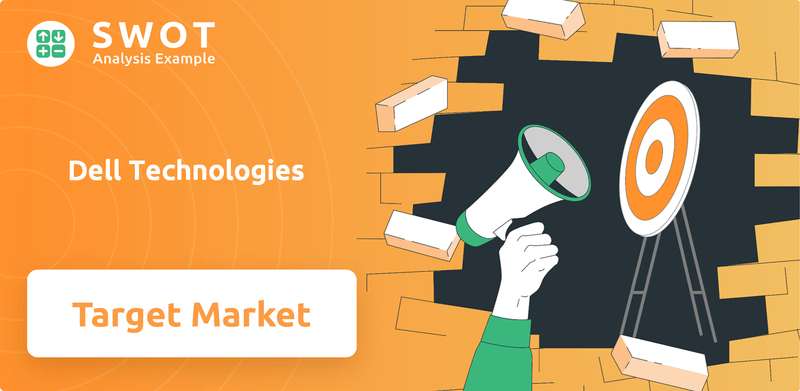
From its origins as a direct-to-consumer PC seller, Dell has transformed into a comprehensive IT solutions provider. Understanding the Dell Technologies SWOT Analysis is crucial to identify the company's position in the market. This evolution necessitates a thorough examination of Dell's customer profile, market segmentation, and how Dell identifies its target market to stay ahead in a competitive landscape. This exploration is essential to understand Dell's customer demographics and its ability to meet the needs of a diverse audience.
Who Are Dell Technologies’s Main Customers?
Understanding the customer base is crucial for any company's success. For Owners & Shareholders of Dell Technologies, this involves analyzing its primary customer segments and the diverse demographics they represent. This analysis helps in tailoring marketing strategies, product development, and customer service to meet specific needs and preferences.
Dell Technologies operates in two main segments: the Client Solutions Group (CSG) and the Infrastructure Solutions Group (ISG). The CSG focuses on client products like desktops and laptops, catering to both commercial and consumer markets. ISG provides infrastructure solutions, including servers and storage, primarily for businesses. Each segment has distinct customer profiles and market dynamics.
Dell's customer base is broad, encompassing individual consumers, businesses of all sizes, and government entities. The company's focus on technological innovation, particularly in areas like AI servers, indicates a strong emphasis on customers who value cutting-edge technology and high performance.
The CSG caters to both commercial and consumer markets, offering desktops, notebooks, and workstations. In fiscal year 2024, this segment generated $48.92 billion in revenue. Commercial client revenue within CSG was $9.6 billion in Q4 fiscal year 2024. For fiscal year 2025, CSG revenue is projected to be $48.39 billion.
ISG focuses on servers, storage, and networking solutions, primarily serving businesses. In fiscal year 2024, ISG generated $33.89 billion in revenue. Substantial growth is expected, with revenue projected to reach $43.59 billion in fiscal year 2025. The company anticipates selling $15 billion in AI servers alone in the coming fiscal year (FY2025).
Dell's market segmentation strategy allows it to tailor offerings to different customer needs. Dell is the third-largest PC OEM worldwide with a 15.4% PC market share as of September 2024. It leads in converged systems with 44.7% market share and mainstream servers with 24.5% market share.
- Commercial Customers: Businesses of all sizes, from small to large enterprises, requiring IT solutions, servers, storage, and networking equipment.
- Consumer Customers: Individuals seeking personal computers, laptops, and other devices for home use.
- Government and Education: Public sector entities and educational institutions that require technology solutions.
- Key Market Segments: The shift towards AI-enabled PCs and AI servers indicates a growing focus on customers who prioritize advanced technology and performance, particularly in the commercial and enterprise sectors.
Dell Technologies SWOT Analysis
- Complete SWOT Breakdown
- Fully Customizable
- Editable in Excel & Word
- Professional Formatting
- Investor-Ready Format
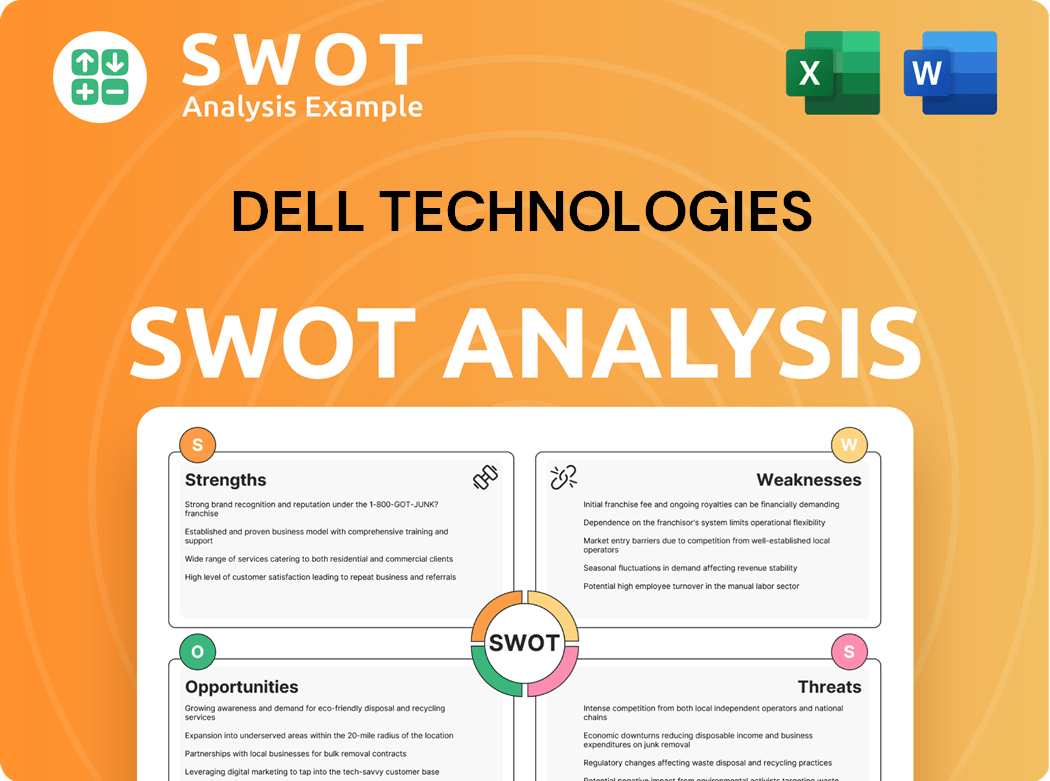
What Do Dell Technologies’s Customers Want?
Customer needs and preferences for technology solutions are central to understanding the market dynamics of the company. The demand for customizable, efficient, and reliable technology solutions drives much of the company's customer base. The company's direct-to-customer sales model allows for tailored products, which is a significant factor in customer choice.
Purchasing behaviors are influenced by cost efficiency, which the company addresses through its direct model, bypassing intermediaries. Decision-making criteria often involve the need for robust IT infrastructure, data management, security solutions, and cloud integration. The company meets these needs with a broad portfolio of products and services.
The company's focus on AI solutions is evident, with nearly 80% of customers in the early stages of GenAI implementation, according to a recent survey. This highlights a key need that the company addresses by embedding AI in its solutions and offering AI-enabled architecture like the Dell AI Factory. The company tailors its offerings to facilitate AI adoption, from AI PCs to AI-optimized servers.
The ability to tailor products to specific requirements is a core driver for choosing the company's offerings. This customization is a cornerstone of the company's direct-to-customer sales model.
The company's direct model allows it to offer competitive pricing by bypassing intermediaries. This approach is a key factor in influencing purchasing decisions.
The company is actively addressing the growing interest in AI solutions. It is embedding AI in its solutions and offering AI-enabled architecture.
The company focuses on creating holistic solutions with embedded security and sustainability. It offers services like PC as a Service (APEX) to enhance customer experience.
Direct customer relationships enable the company to respond swiftly to changing demands. This approach allows for tailored solutions and fosters customer loyalty.
Decision-making criteria for businesses often involve the need for robust IT infrastructure. The company provides a broad portfolio from the edge to the core to the cloud.
The company's customer base includes individual consumers, small businesses, and large enterprises, each with unique needs. The company's market segmentation strategy caters to these diverse groups, offering tailored solutions and services. Understanding the company's customer profile is crucial for effective marketing and product development. For a deeper understanding of the competitive landscape, it's useful to consider the Competitors Landscape of Dell Technologies.
The company's target market is diverse, including individual consumers, small businesses, and large enterprises. These customers seek a range of solutions, from personal computing devices to complex IT infrastructure. The company's customer acquisition strategies focus on direct sales, partnerships, and online channels to reach these varied segments.
- Customization: Tailored products to meet specific requirements.
- Cost Efficiency: Competitive pricing through direct sales.
- AI Integration: Solutions to facilitate AI adoption.
- Robust IT Infrastructure: Servers, storage, and networking solutions.
- Holistic Solutions: Embedded security and sustainability.
Dell Technologies PESTLE Analysis
- Covers All 6 PESTLE Categories
- No Research Needed – Save Hours of Work
- Built by Experts, Trusted by Consultants
- Instant Download, Ready to Use
- 100% Editable, Fully Customizable
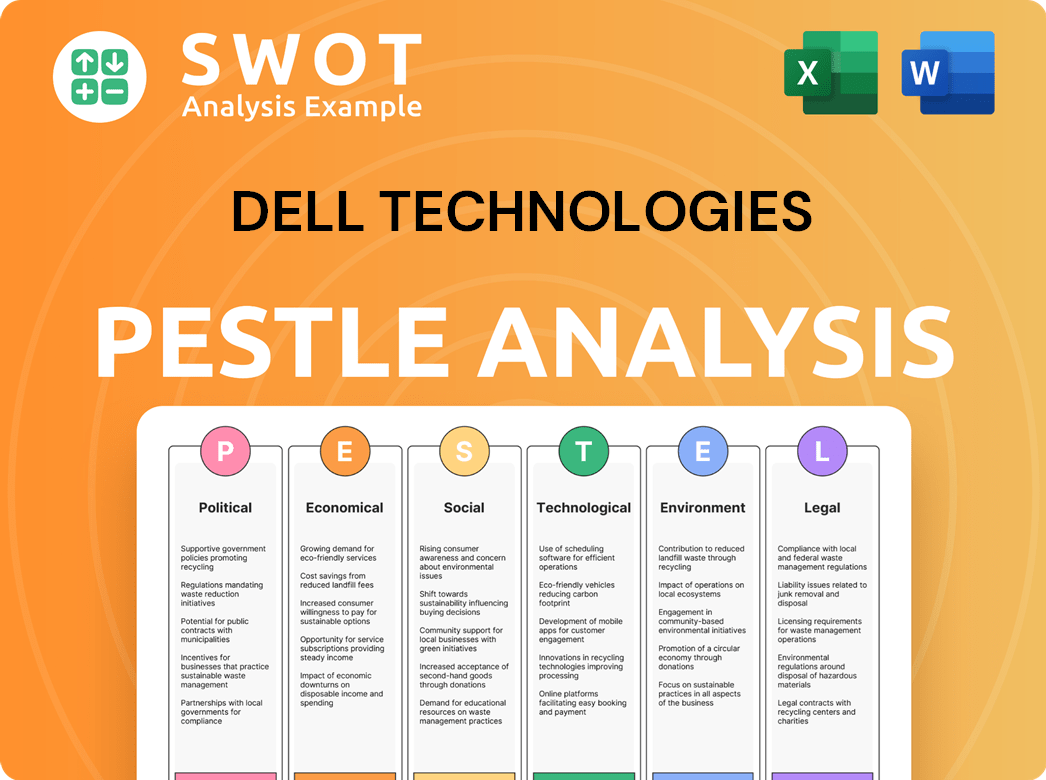
Where does Dell Technologies operate?
Geographically, Dell Technologies maintains a substantial global presence, serving customers across approximately 180 countries. This extensive reach allows the company to cater to diverse markets, including the Americas, Europe, the Middle East, Asia, and other international regions. The company's widespread operations enable it to capture a broad customer base and adapt to varying regional demands.
In fiscal year 2024, Dell's revenue distribution showed a balanced split between the United States and Non-US markets. Non-US markets generated $44.44 billion, representing 50.26% of total revenue, while the United States generated $43.99 billion, accounting for 49.74%. This indicates a strong international presence and the ability to generate significant revenue outside of its home market.
However, in fiscal year 2025, the United States market showed strong growth, with revenue increasing by 15.98% from 2024 to $51.01 billion, now representing 53.38% of total revenue. Non-US revenue also increased slightly to $44.55 billion, but its percentage share of total revenue decreased to 46.62% in fiscal year 2025. This shift highlights the importance of the US market and its increasing contribution to overall revenue.
To succeed in diverse markets, Dell localizes its offerings and marketing strategies. This approach allows the company to tailor its products and services to meet specific regional demands and preferences. By understanding local market dynamics, Dell can enhance customer engagement and drive sales growth.
In December 2024, Dell Technologies focused on training partners in the Asia Pacific region to be trusted advisors for customers' digital journeys. This initiative aims to create a structured and simplified ecosystem that concentrates on various aspects of Dell's portfolio. The emphasis on partner training underscores Dell's commitment to providing comprehensive solutions and support in key markets.
Dell strategically focuses on key growth markets such as Brazil, Russia, India, and China. These markets are supported by a robust supply chain and product development infrastructure, enabling Dell to offer customized solutions. This strategic focus helps the company capitalize on emerging opportunities and strengthen its global market position.
Despite global challenges in the PC market, Dell's geographic diversification helps mitigate the impact of economic slowdowns in specific regions. By operating across multiple markets, Dell reduces its reliance on any single region, providing a buffer against economic fluctuations. This diversification strategy supports the company's long-term sustainability and resilience.
Understanding the customer demographics Dell serves is crucial for tailoring its market strategies. Dell's target market varies by region, with different products and marketing approaches used to appeal to local preferences. For example, in the United States, Dell's focus might be on high-performance computing solutions for businesses, while in emerging markets, it could be on affordable laptops and tablets for consumers.
Dell's customer profile is segmented based on various factors, including industry, company size, and technology needs. This Dell market segmentation allows the company to customize its offerings and marketing efforts. For instance, large enterprises receive tailored solutions, while small and medium-sized businesses (SMBs) benefit from specific product bundles. For more information about Dell Technologies audience, you can explore articles like this one.
Dell Technologies Business Model Canvas
- Complete 9-Block Business Model Canvas
- Effortlessly Communicate Your Business Strategy
- Investor-Ready BMC Format
- 100% Editable and Customizable
- Clear and Structured Layout
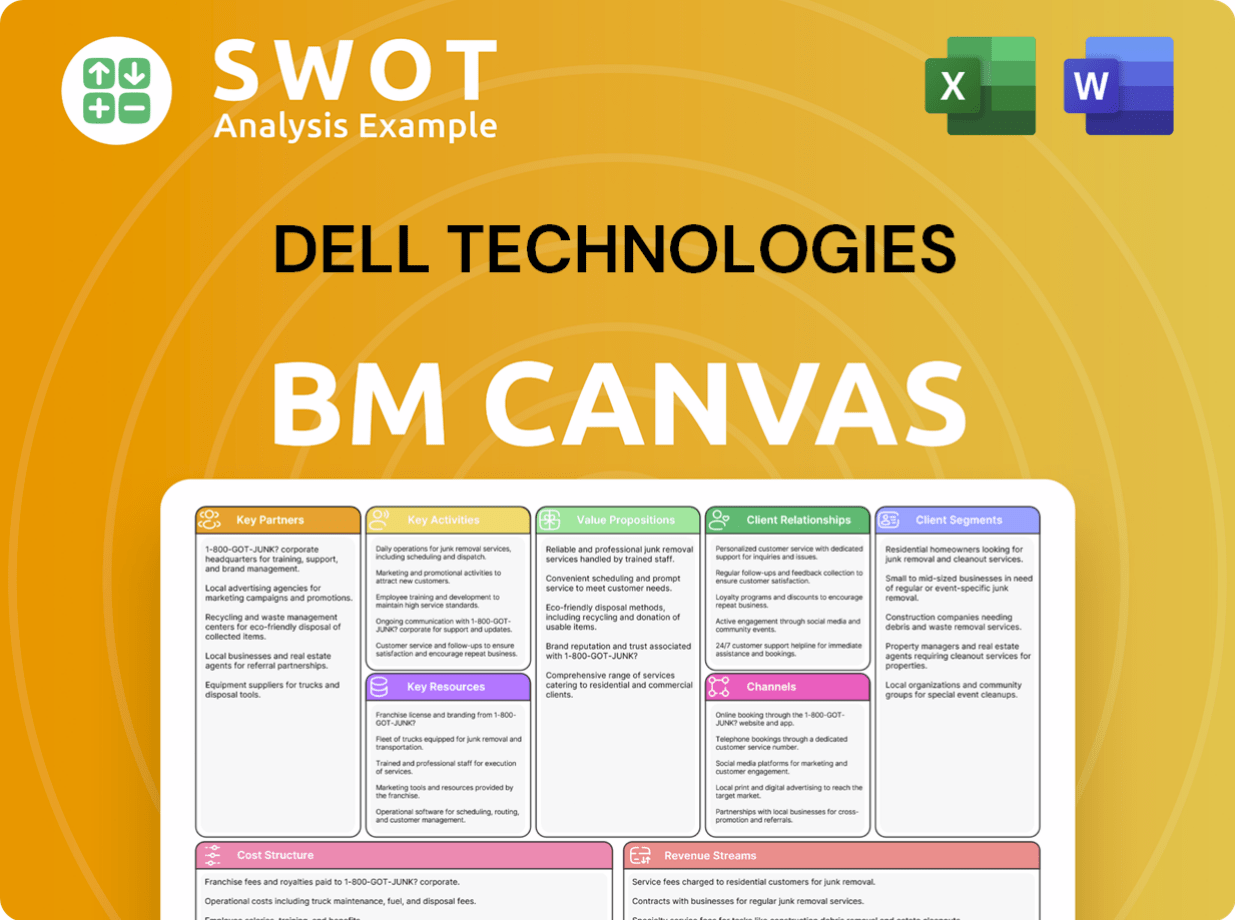
How Does Dell Technologies Win & Keep Customers?
Understanding customer acquisition and retention is crucial for the success of any technology company. For Dell Technologies, a comprehensive approach is employed, focusing on both attracting new customers and keeping existing ones satisfied. This strategy leverages the company's established direct sales model, strategic partnerships, and a strong customer-centric philosophy to drive growth and maintain market leadership.
The direct sales model allows for building closer relationships with customers, providing valuable insights into their needs and preferences. This customer-centric approach is further enhanced by targeted marketing campaigns and strategic alliances. By tailoring solutions to specific market needs and continuously innovating, Dell Technologies aims to build long-term customer loyalty and drive sustainable business growth. The company's focus on AI-optimized servers, with a projected $15 billion in sales in fiscal year 2025, is a clear indication of its acquisition strategies targeting the burgeoning AI market.
Customer acquisition strategies include targeted online ads, search engine optimization, and social media campaigns. These efforts are designed to reach diverse customer segments, from small businesses seeking affordable, customizable systems to large enterprises requiring high-end technology solutions. Partnerships with industry leaders, such as NVIDIA and Intel, further strengthen Dell Technologies's market position and enhance its ability to innovate. These partnerships help to bolster the brand and position it at the forefront of technological innovation.
The direct sales model allows for building strong customer relationships. This model provides valuable insights into customer needs and preferences. The focus on direct sales contributes to both customer acquisition and retention.
Partnerships with companies like NVIDIA and Intel enhance brand value. These partnerships position Dell Technologies at the forefront of innovation. They support the development of cutting-edge technology solutions. This helps in reaching a broader customer base.
Targeted online advertising is used to reach potential customers. Search engine optimization (SEO) improves online visibility. Social media campaigns engage diverse customer segments. Marketing campaigns tailor solutions to specific market needs.
Dell Technologies focuses on delivering solutions that meet evolving customer needs. The PC as a Service (PCaaS) offering, APEX, helps customers. This fosters long-term relationships. This approach enhances customer experiences and operational efficiency.
Retention strategies are deeply embedded in Dell Technologies's customer-centric approach. Personalization is key, with real-time insights used to tailor interactions and deliver customized solutions. This includes automating tailored follow-up messages and identifying micro-segments for targeted campaigns. The company's PC as a Service (PCaaS) offering, APEX, allows customers to transfer IT management burdens to Dell Technologies, fostering long-term relationships. The focus on customer-centric innovation ensures products and solutions meet evolving needs, enhancing customer experiences and operational efficiency. For more insights, you can read a Brief History of Dell Technologies.
Real-time insights are used to tailor customer interactions. Customized solutions are delivered to meet specific needs. This strategy enhances customer satisfaction and loyalty.
The APEX offering allows customers to transfer IT management burdens. This fosters long-term relationships. It provides a convenient and efficient solution for clients.
The 2025 Partner Program offers enhanced growth incentives. These include a 2% Storage+ growth incentive. There is also a 1.5% Client growth incentive for Titanium partners.
Dell Technologies focuses on building customer loyalty through shared values. This makes customers feel good about associating with the brand. This strategy enhances customer retention.
Dell Technologies provides customer service for different market segments. This ensures that customers receive tailored support. This approach enhances customer satisfaction.
Dell Technologies uses market segmentation to target customers. This allows for tailored marketing strategies. This approach enhances customer acquisition.
Dell Technologies Porter's Five Forces Analysis
- Covers All 5 Competitive Forces in Detail
- Structured for Consultants, Students, and Founders
- 100% Editable in Microsoft Word & Excel
- Instant Digital Download – Use Immediately
- Compatible with Mac & PC – Fully Unlocked
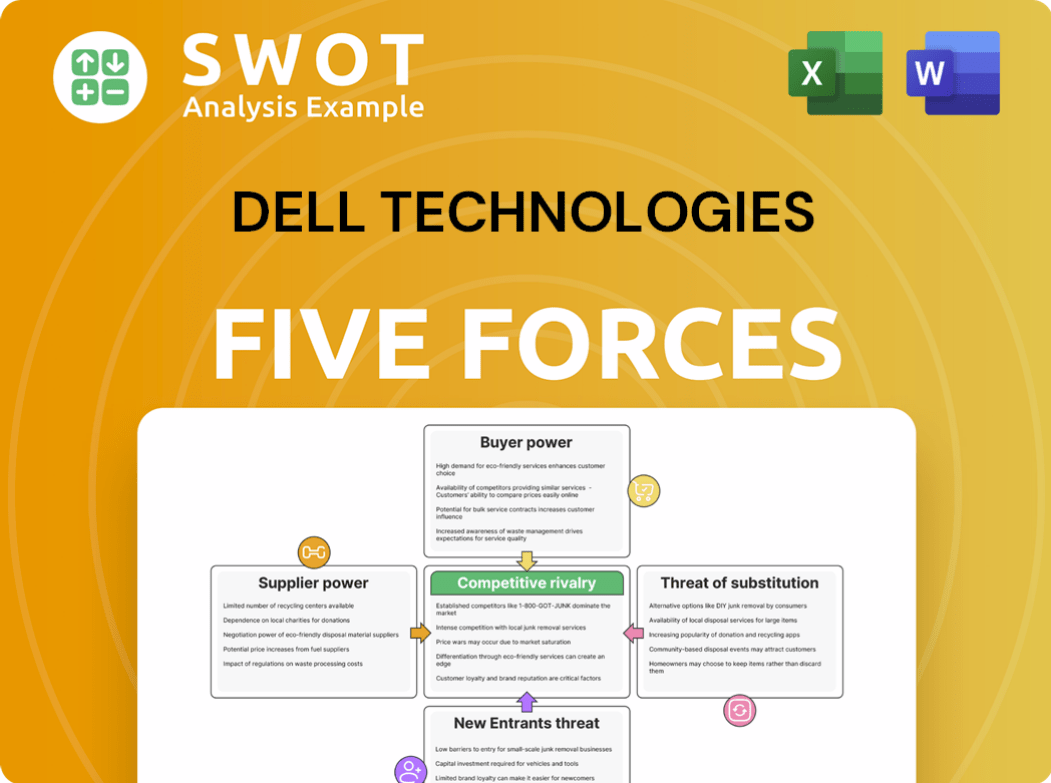
Related Blogs
- What are Mission Vision & Core Values of Dell Technologies Company?
- What is Competitive Landscape of Dell Technologies Company?
- What is Growth Strategy and Future Prospects of Dell Technologies Company?
- How Does Dell Technologies Company Work?
- What is Sales and Marketing Strategy of Dell Technologies Company?
- What is Brief History of Dell Technologies Company?
- Who Owns Dell Technologies Company?
Disclaimer
All information, articles, and product details provided on this website are for general informational and educational purposes only. We do not claim any ownership over, nor do we intend to infringe upon, any trademarks, copyrights, logos, brand names, or other intellectual property mentioned or depicted on this site. Such intellectual property remains the property of its respective owners, and any references here are made solely for identification or informational purposes, without implying any affiliation, endorsement, or partnership.
We make no representations or warranties, express or implied, regarding the accuracy, completeness, or suitability of any content or products presented. Nothing on this website should be construed as legal, tax, investment, financial, medical, or other professional advice. In addition, no part of this site—including articles or product references—constitutes a solicitation, recommendation, endorsement, advertisement, or offer to buy or sell any securities, franchises, or other financial instruments, particularly in jurisdictions where such activity would be unlawful.
All content is of a general nature and may not address the specific circumstances of any individual or entity. It is not a substitute for professional advice or services. Any actions you take based on the information provided here are strictly at your own risk. You accept full responsibility for any decisions or outcomes arising from your use of this website and agree to release us from any liability in connection with your use of, or reliance upon, the content or products found herein.